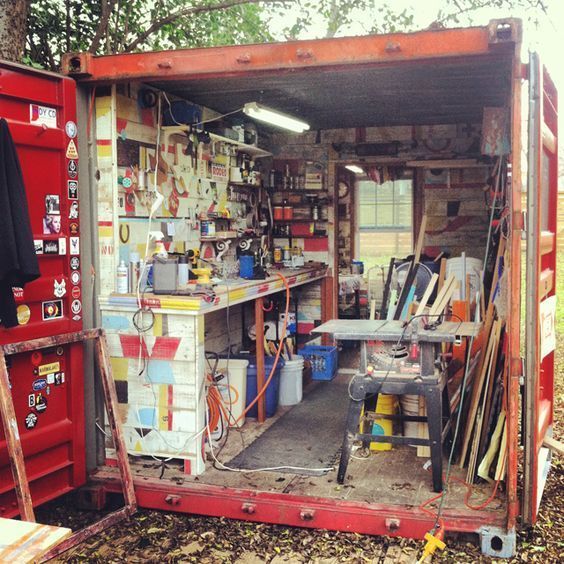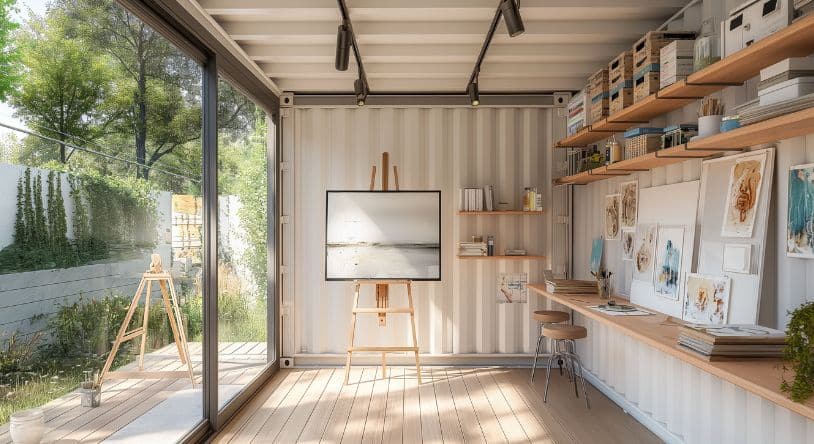
Creative Containers: Workshops & Studios in 2025
Creative Containers: Workshops & Studios in 2025
In an era where creative space comes at a premium, innovative thinkers are turning to an unexpected resource: shipping containers. These robust steel structures—originally designed to transport goods across oceans—are now housing everything from woodworking shops to photography studios, providing affordable, flexible, and distinctive spaces for creative professionals and hobbyists alike. Who knew that the secret to unleashing your creativity was actually sitting in a shipping yard this whole time?
Why Shipping Containers Make Perfect Workshops & Studios
The marriage between shipping containers and creative spaces isn’t just a trendy aesthetic choice—it’s a practical solution with numerous advantages that traditional buildings simply can’t match.
Affordability That Fuels Creativity
For many artists, craftspeople, and entrepreneurs, the cost of dedicated workspace can be prohibitively expensive. Shipping container conversions offer a budget-friendly alternative:
- Lower initial investment: A quality used container can cost significantly less than constructing a comparable space from scratch
- Reduced construction timeline: Convert and customize in weeks rather than months
- Minimal foundation requirements: Simple foundation systems reduce site preparation costs
- Predictable budgeting: The container itself provides a finished structure, making renovation costs more predictable
This economic advantage allows creative professionals to invest more in equipment and materials rather than overhead costs. After all, your masterpiece won’t create itself if all your money went to paying rent on that fancy downtown studio!
Mobility for Changing Needs
Unlike permanent structures, container studios offer remarkable flexibility:
- Relocatable design: Move your workspace as your life or business evolves
- Expand incrementally: Start with one container and add more as your needs grow
- Test before committing: Place a container studio on property you’re considering purchasing
- Follow opportunity: Take your workshop to job sites, events, or collaborative spaces
This mobility is particularly valuable for artists who teach workshops in different locations or craftspeople who need to bring their skills to various project sites. It’s like having a creative superpower—you can literally pick up your entire studio and move it somewhere else. Try doing that with a traditional building without a very large crane and some explaining to do!
Customization for Specialized Needs
Every creative discipline has unique spatial requirements, and containers provide a blank canvas that can be tailored precisely:
- Strategic openings: Create large doors for oversized materials or finished pieces
- Custom lighting: Install skylights, windows, or specialized lighting systems
- Climate control: Add insulation and HVAC systems designed for your specific work
- Electrical customization: Configure power to accommodate specialized equipment
- Sound management: Implement sound dampening for music studios or noisy tools
The standardized dimensions actually encourage creative problem-solving and efficient use of space. It’s like the ultimate adult Tetris game, except instead of disappearing when you complete a row, you get a perfectly optimized creative workspace!
Durability That Protects Your Investment
Built to withstand ocean voyages and stacking stresses, shipping containers offer exceptional durability:
- Weather resistance: Protection from rain, wind, and environmental threats
- Security: Steel construction provides natural protection for valuable equipment and materials
- Low maintenance: Minimal upkeep requirements compared to traditional structures
- Fire resistance: Steel construction offers inherent fire-resistant properties
- Longevity: Potential lifespan of decades with basic maintenance
For workshops containing expensive tools or studios housing valuable artwork, this built-in security and durability provides peace of mind. These containers survived ocean storms and international shipping—they can certainly handle whatever creative chaos you throw at them! Your neighbor’s shed might blow away in a strong wind, but your container studio will still be standing there, looking slightly smug.
Popular Creative Applications
The versatility of shipping containers has led to an impressive variety of workshop and studio applications. Here are some of the most successful implementations we’ve seen:
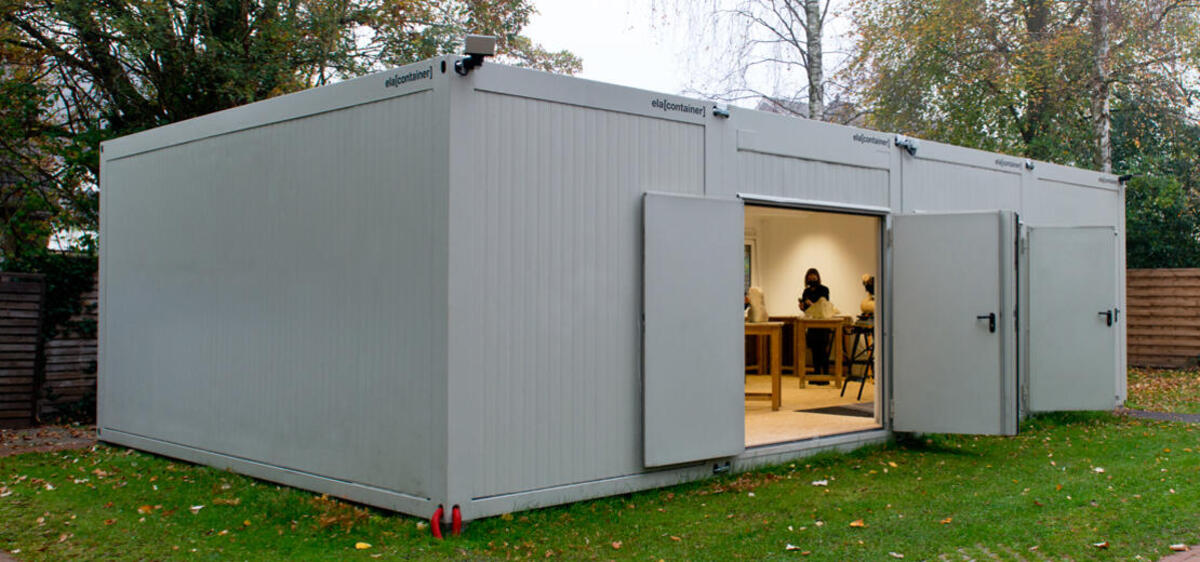
Art Studios That Inspire
Visual artists have embraced container studios for several compelling reasons:
- Natural light opportunities: Strategic window placement can create ideal north-facing light
- Ventilation control: Critical for artists working with paints, resins, or other chemicals
- Cleanable surfaces: Modified container interiors withstand paint splatter and artistic messes
- Exhibition potential: The studio itself can become a gallery space for shows
- Outdoor connection: Position doors to open onto inspiring landscapes or garden spaces
Many painters have converted 40-foot high-cube containers into light-filled studios that double as small galleries during open studio events. The high ceilings allow artists to work on large-scale canvases, while the industrial aesthetic complements contemporary styles. Plus, when visitors ask “Where’s your studio?” you get to say “In that shipping container over there,” which is guaranteed to make you at least 40% more interesting at parties.
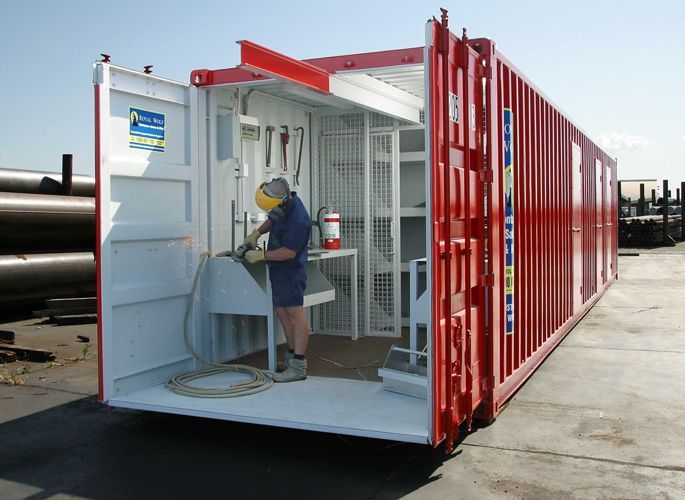
Woodworking Shops That Perform
Woodworkers find containers particularly advantageous for their craft:
- Dust management: Contained environment allows for effective dust collection systems
- Tool organization: Wall-mounted storage maximizes floor space for larger equipment
- Sound containment: Additional insulation keeps noisy operations from disturbing neighbors
- Climate control: Protect wood and tools from humidity and temperature fluctuations
- Security: Valuable tools remain protected in the steel structure
Many master craftspeople operate custom furniture businesses from two connected 20-foot containers. This configuration provides dedicated areas for machine work and hand tool usage, with large doors that open to extend the workspace outdoors in good weather. And let’s be honest—sawdust is much easier to sweep out of a container than it is to explain to your spouse why it’s coating every surface in the house basement. “It’s contained in the container” has a nice ring to it!
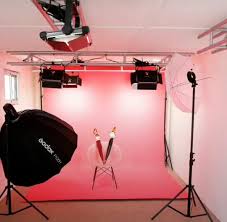
Photography Studios That Deliver
Professional photographers benefit from the controlled environment containers provide:
- Configurable lighting: Create permanent mounts for studio lights and modifiers
- Backdrop systems: Install tracking systems for seamless background changes
- Client areas: Designate comfortable spaces for viewing sessions
- Equipment security: Protect valuable camera gear and computers
- Complete darkness option: Create a studio that can achieve perfect blackout conditions
Professional photographers have transformed 40-foot containers into sophisticated studios with multiple shooting areas, changing rooms for clients, and post-production workspaces. The container’s long, narrow dimensions prove ideal for creating distance between subject and background.
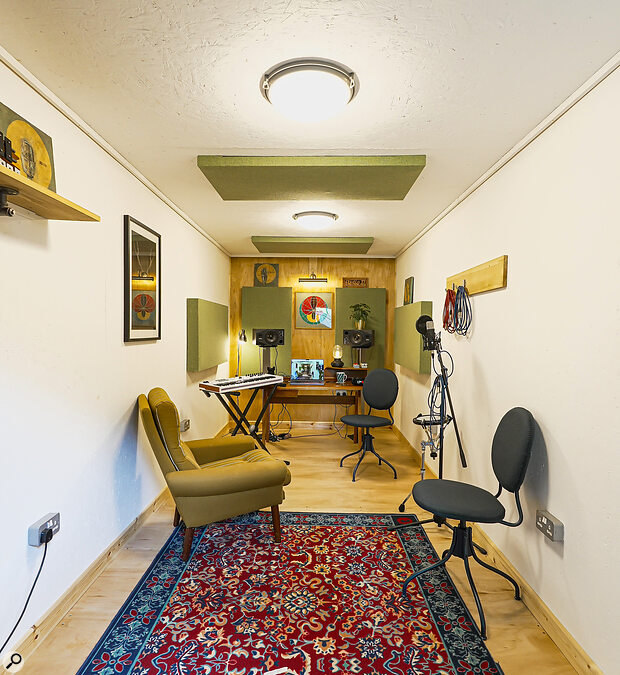
Music Recording Spaces That Sound Amazing
Musicians and producers have discovered that containers can be acoustically excellent:
- Sound isolation: Additional insulation creates impressive sound separation
- Room-within-room construction: Float floors and walls to prevent vibration transfer
- Custom acoustic treatments: Shape the sound to your specific musical genre
- Equipment security: Protect valuable instruments and recording gear
- Creative atmosphere: Design a space that inspires musical creativity
Some innovative producers have created mobile recording studios in 20-foot containers that they bring to music festivals, capturing live performances and offering on-site recording sessions to artists between their sets. The irony isn’t lost on us—the very containers that once transported vinyl records and musical instruments are now being used to create the music itself. Talk about a career change!
Maker Spaces That Foster Collaboration
Some of the most innovative container conversions serve multiple creative disciplines:
- Shared equipment areas: Maximize expensive tools through communal access
- Flexible configurations: Arrange and rearrange as projects demand
- Cost sharing: Distribute expenses among multiple creative professionals
- Cross-pollination: Encourage collaboration between different disciplines
- Workshop capability: Host classes and skill-sharing sessions
Several creative collectives across the country combine multiple shipping containers around central courtyards to house different creative professionals ranging from metalsmiths to digital designers, with common areas for collaboration and client meetings.
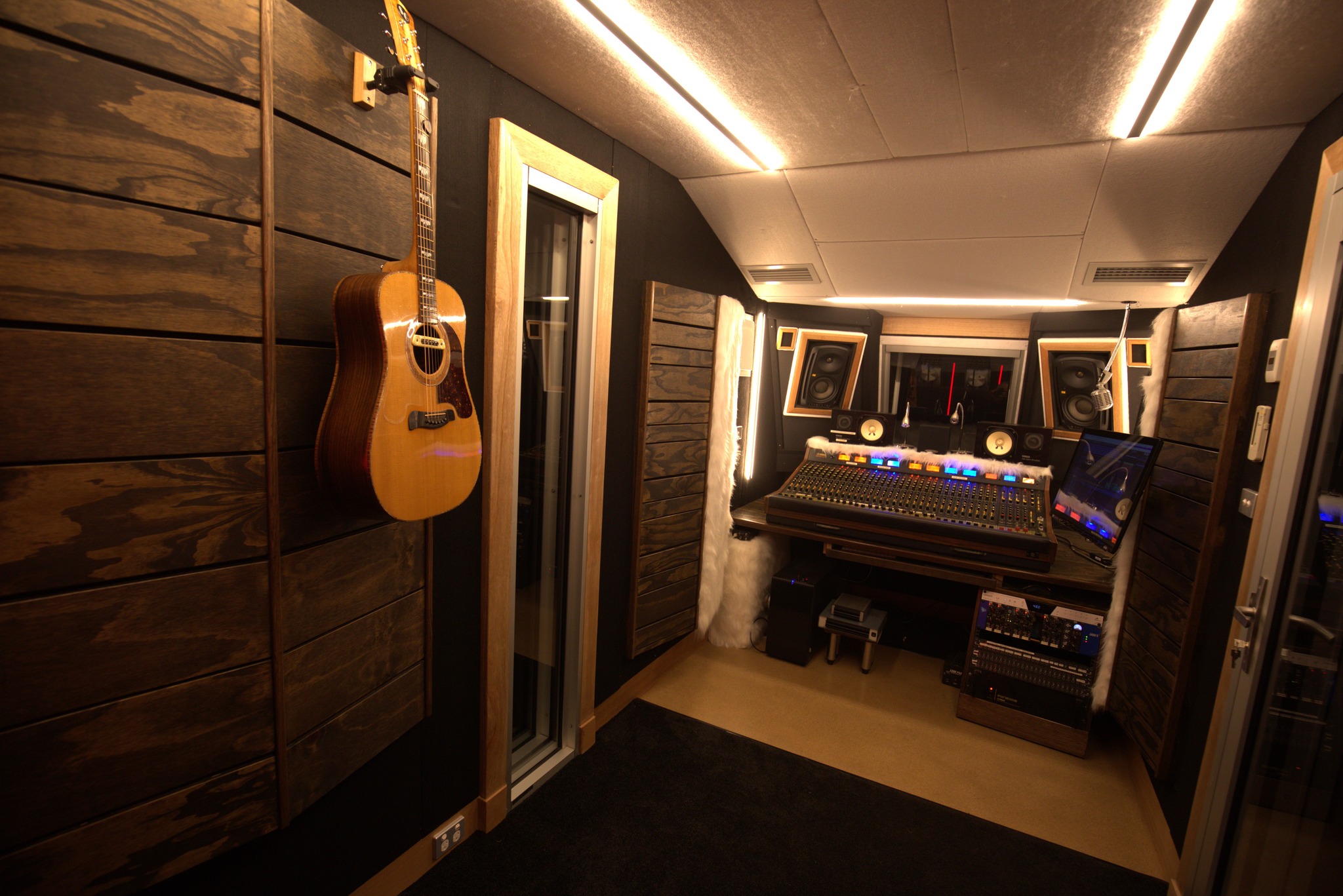
Practical Considerations for Your Container Workshop
Converting a shipping container into a functional workshop or studio requires thoughtful planning. Here are the key factors to consider:
Selecting the Right Container
Not all shipping containers are created equal:
- Size options: Standard 20-foot and 40-foot containers are most common, with 40-foot high-cube containers offering additional ceiling height beneficial for many creative applications
- Condition grades: From “one-trip” (nearly new) to “wind and watertight” (used older containers) to “cargo worthy” (used but younger containers)
- Door configurations: Standard containers have end doors, while side-opening containers offer wider access
For workshop applications where heavy equipment will be installed, structural considerations become particularly important. And while we’re on the subject, the term “one-trip container” sounds like it just took a quick weekend getaway to Bermuda, when in reality it probably sailed halfway around the world with a full cargo load. If only our vacations were that productive!
Essential Modifications
Raw shipping containers require several important modifications to become comfortable working spaces:
Climate Management
Steel conducts heat and cold efficiently, making climate control critical:
- Insulation options: Spray foam maximizes space efficiency while rigid board systems create clean interior surfaces
- Ventilation systems: Essential for workshops using chemicals, generating dust, or creating fumes
- Heating solutions: Mini-split systems offer efficient heating that can be zoned for different areas
- Cooling requirements: Consider both human comfort and equipment/material protection
- Dehumidification: Critical in many regions to protect tools and materials
For pottery studios or other workshops generating significant heat, creating multiple ventilation options becomes especially important. Just remember that without proper insulation, your container studio could double as a sauna in summer and a freezer in winter—great for Nordic spa enthusiasts, less ideal for delicate artistic processes!
Power Systems
Creative work typically requires robust electrical systems:
- Service sizing: Determine total amperage needs based on equipment requirements
- Circuit planning: Separate circuits for high-draw equipment like kilns or shop vacs
- Outlet placement: Position power where you’ll actually use it, including ceiling drops
- Lighting design: Combine ambient, task, and specialty lighting appropriate to your discipline
- Alternative energy: Consider solar options for remote locations or to reduce operating costs
Experienced woodworkers typically incorporate 100-amp subpanels into their container workshops with dedicated circuits for table saws, dust collection systems, and air compressors, eliminating tripped breakers during intensive work sessions.
Structural Modifications
Many workshops benefit from customized openings:
- Window placement: Strategic positioning can maximize natural light while minimizing heat gain
- Door upgrades: Consider roll-up doors, glass sliding doors, or bifold systems for improved access
- Floor reinforcement: May be necessary for extremely heavy equipment
- Interior walls: Create separate spaces for different functions or to control dust/noise
- Ceiling height: High-cube containers provide valuable additional headroom
Professional metalsmiths often install custom exhaust hoods and fire-resistant wall sections in their container workshops to safely accommodate welding and forging equipment.
Permitting and Placement
Regulatory considerations vary widely by location:
- Zoning regulations: Check local rules regarding workshop usage on your property
- Permit requirements: Some jurisdictions classify container structures as temporary buildings while others apply full building code requirements
- Setback rules: Distance requirements from property lines and other structures
- Foundation needs: From simple gravel beds to full concrete foundations depending on permanence and local codes
- Utility connections: Planning for water, sewer, and electrical service
Always consult local authorities before purchasing a container or beginning conversion work.
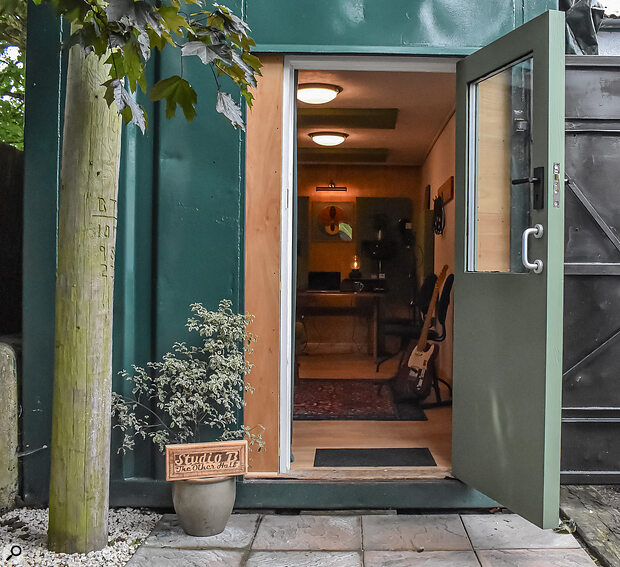
Getting Started: Your Container Workshop Journey
If you’re inspired to create your own container workshop or studio, follow these steps to ensure success:
1. Define Your Specific Needs
Before shopping for containers, clarify:
- Minimum space requirements
- Equipment dimensions and weight
- Storage needs
- Client/visitor accommodations
- Environmental controls required by your discipline
Document these requirements as a checklist for evaluating container options. This prevents the “ooh, shiny container!” syndrome where you fall in love with a container before figuring out if your industrial lathe will actually fit through the door.
2. Research Local Regulations
Contact your local building department to understand:
- Permit requirements
- Zoning restrictions
- Building code application
- Inspection processes
- Utility connection procedures
This step can save significant time and money by preventing regulatory surprises.
3. Source Quality Containers
Work with reputable suppliers who:
- Offer delivery and placement services
- Can verify structural integrity
- Stand behind their products with clear warranties
Remember that the initial container quality significantly impacts the success of your conversion project.
4. Plan Thoughtful Modifications
Consider working with professionals who understand:
- Structural implications of container modifications
- Insulation strategies for working environments
- Electrical requirements for creative equipment
- HVAC sizing for workshop applications
- Sound management techniques
Even if you plan to DIY much of the work, consulting with experts during planning can prevent costly mistakes.
5. Prepare for Success
Beyond the container itself, plan for:
- Appropriate tools and equipment for the conversion process
- Timeline that accounts for weather conditions
- Budget that includes contingency funding
- Storage for materials during the conversion
- Temporary workspace if you’re transitioning from an existing studio
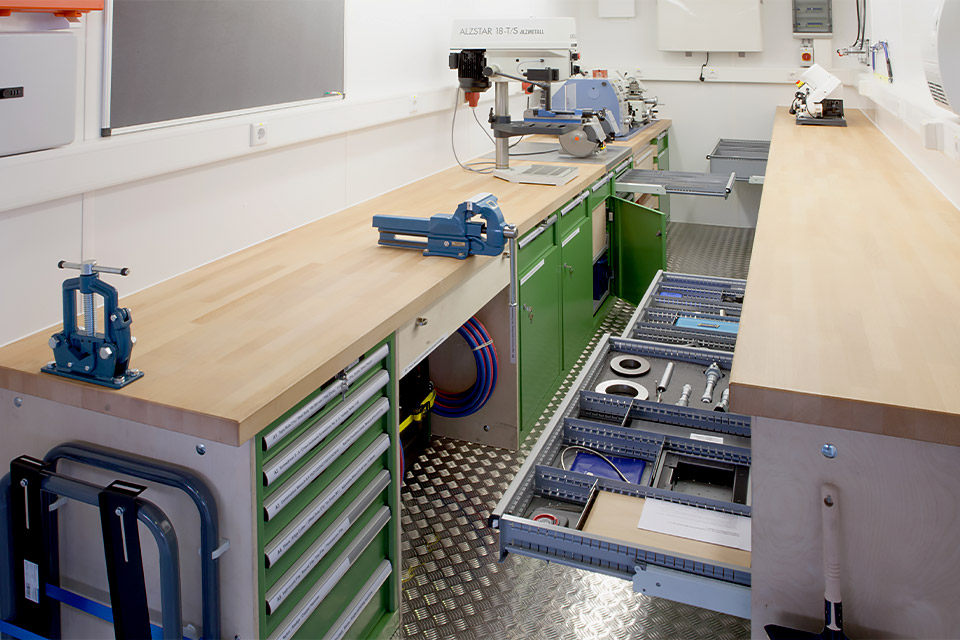
Why Choose Used Conex for Your Container Workshop Project
When you’re ready to create your container workshop or studio, the Used Conex team offers unparalleled expertise:
- Extensive inventory: Used Conex maintains a large selection of containers in various sizes and conditions to match your specific needs and budget
- Quality assurance: Every container undergoes thorough inspection before sale
- Delivery and placement: Precise positioning on your site with specialized equipment
- Ongoing support: Customer support throughout your container purchase
Used Conex customers consistently report that having a knowledgeable partner throughout the process makes all the difference in creating successful creative spaces.
Conclusion: Your Creative Space Awaits
A shipping container workshop or studio represents more than just an affordable space solution—it’s a statement about creativity, sustainability, and thinking beyond conventional boundaries. By repurposing these industrial structures into vibrant creative spaces, you’re participating in a movement that values resourcefulness and imagination.
Whether you’re a weekend woodworker looking for dedicated space to pursue your passion or a professional artist seeking an affordable studio solution, container conversion offers a pathway to realize your creative vision without breaking the bank.
After all, if these containers can survive months at sea battling storms and salt spray, they can certainly handle your experimental pottery phase or that time you decide to try chainsaw ice sculpture. Just remember to open the doors first.
Contact Used Conex today at UsedConex.com to discuss how we can help match you with the perfect container for your workshop or studio project. Your creative journey deserves a space designed to support it—let Used Conex help you build it.
This blog post is brought to you by Used Conex – Your trusted source for quality shipping containers and creative container solutions. Visit UsedConex.com for more information.


